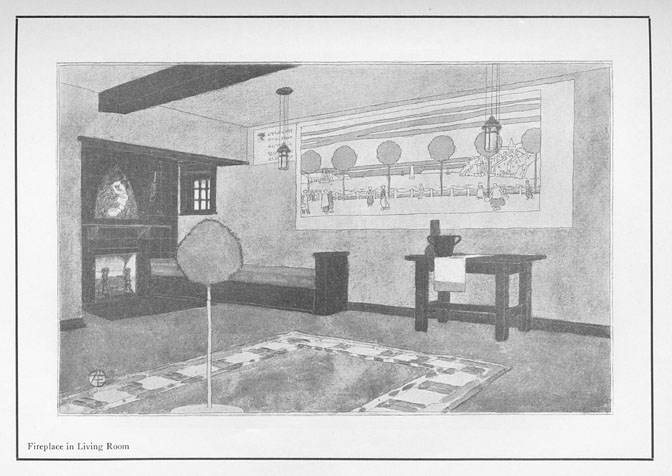Gustav Stickley’s Textiles in the Craftsman Interior - continued
page 3
...
Wall Hangings
Soon after the appearance of table linens in Craftsman interiors, the first verifiable textile designs by Stickley’s firm were primarily designs for wall hangings by Harvey Ellis published in The Craftsman in July 1903.
 Illustration 4 Craftsman Magazine, July 1903, Havey Ellis wall hanging.
Illustration 4 Craftsman Magazine, July 1903, Havey Ellis wall hanging.
Ellis had recently joined the firm, bringing his highly creative artistic and design talents. [viii] The wall hangings, mostly pictorial with medieval influences, can be viewed as an experiment in defining the Craftsman interior. While it is unknown whether the large landscape hanging was actually made, an accompanying article in the same issue states “(a) number of successful experiments have recently been made in the embroidery department of the rapidly multiplying Craftsman workshops” with illustrations of two Ellis designed wall hangings. [ix]
The most ambitious of Ellis’ designs for wall hangings followed in the August 1903 issue, as a series of eight panels illustrating the fairy tale “Puss in Boots” to be worked in appliqué and embroidery. This work was not presented as product for sale, but as encouragement for the creativity of home needleworkers and as inspiration for the creation of a new concept for the role of home decoration – to educate and provide cheer and culture. As evidence, the article is much more than a presentation of a needlework project, only three of the thirteen pages give instruction in the process of working and color placement. The balance of the article is a treatise on the role of the fairy tale throughout history, delving into psychology, ancient politics and literary analysis.[x] Rather heady material. While not all elements of the Craftsman interior decorative scheme carried such meaning, it illustrates the sincerity which the architects of this new emerging movement and design style placed on their work.
[ ill. ILLUSTRAION P&B ]
The age of materialism, fact and science, the demand for the tangible, the visible, the positive, do not apparently diminish the fascinations of the fairy tale.… the two types of the teller of wonder-tales: the one who imagines adventures, splendors, strange transformations, monstrous creations of Nature, simply for the pleasure he derives in giving play to his fancy and of noting its effect upon his listeners… The other story-teller is a satirist, one who feels keenly-most often, a member of a suffering and oppressed class whose only weapons are words of which the sharpness may glitter and play, but must never strike.… Out of such oppression, out of such fear and hatred of tyrants, there arose a peculiar literary type: a personage who, as time went on, often disguised, or even lost his political significance; who was the embodiment of the people's wisdom and sagacity; one who possessed all the cunning, the petty meanesses, the deceit of the slave and of the slavish nature; the forerunner of the revolutionist, the relative of the Figaros and the Talleyrands; that is, the talking animal.… Puss, the king, the ogre, the poor miller, and the reapers threatened with being chopped into mincemeat, may appear to be fantastic inventions made to in sure the peace and pleasure of the nursery. But under other condi tions of society, we might say-almost in another world-they served another purpose. They exercised in the infancy of races and peo ples the same functions which they no w exercise in the infancy of in dividuals.
- from The Craftsman , Vol. IV, No. 5 (August 1903) Puss in boots: an old myth in new dress, pp. 371-383.
[viii] For extended information on Harvey Ellis’ and other designers contributions to textile designs for Gustav Stickley, see Cathers pp. 154-164.
[ix] The Craftsman , Vol. IV, No. 4 (July 1903) “Examples of The Craftsman Wall Hangings, p. 289.
[x] The Craftsman , Vol. IV, No. 5 (August 1903) Puss in boots: an old myth in new dress, pp. 371-383. Most likely never constructed at the time, for images of a current creation of these panels see Ray Stubblebine, Stickley’s Craftsman Homes: plans, drawings, photograghs; Gibbs Smith, 2006 pp. 24-25 and Cathers p 158-159.
Arts & Crafts Period Textiles • Dianne Ayres - proprietor
Telephone 510-654-1645 • email: ACPTextile@aol.com
5427 Telegraph Avenue, #W2 • Oakland, California 94609
• Workshop open by appointment •
Home • Online Catalog • Curtains • Resources • Contact Us